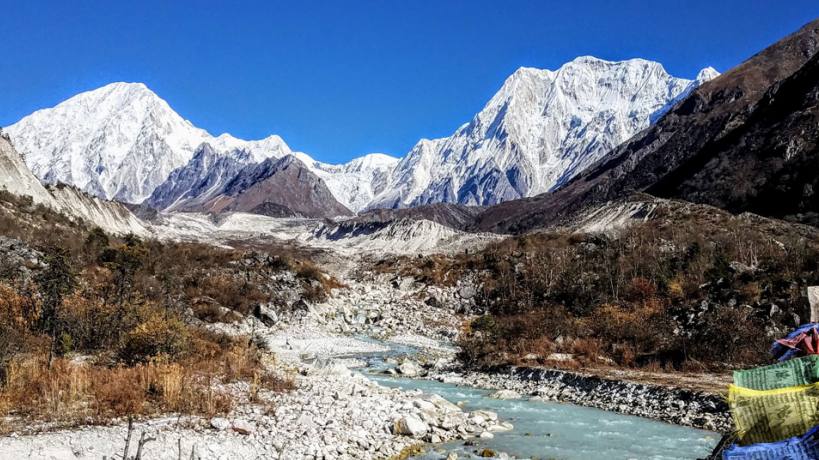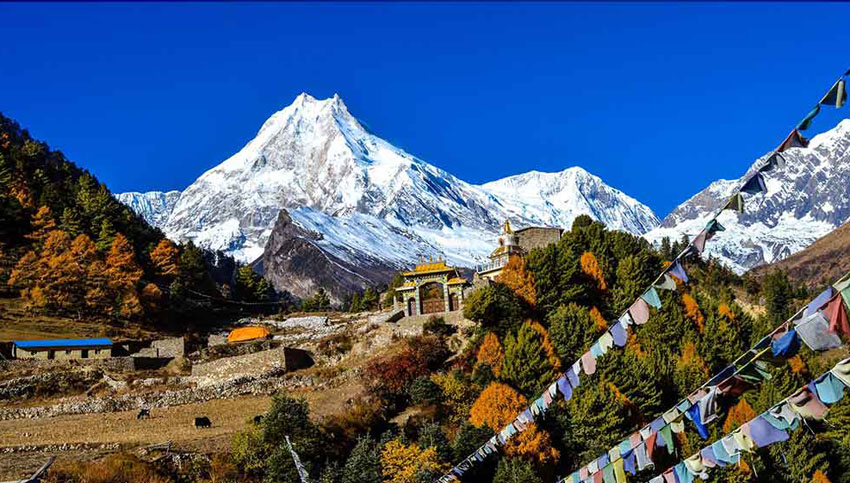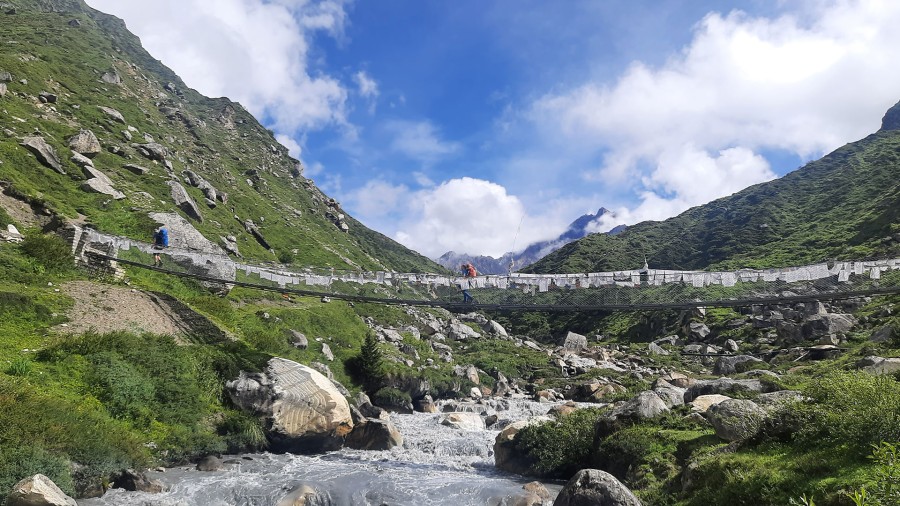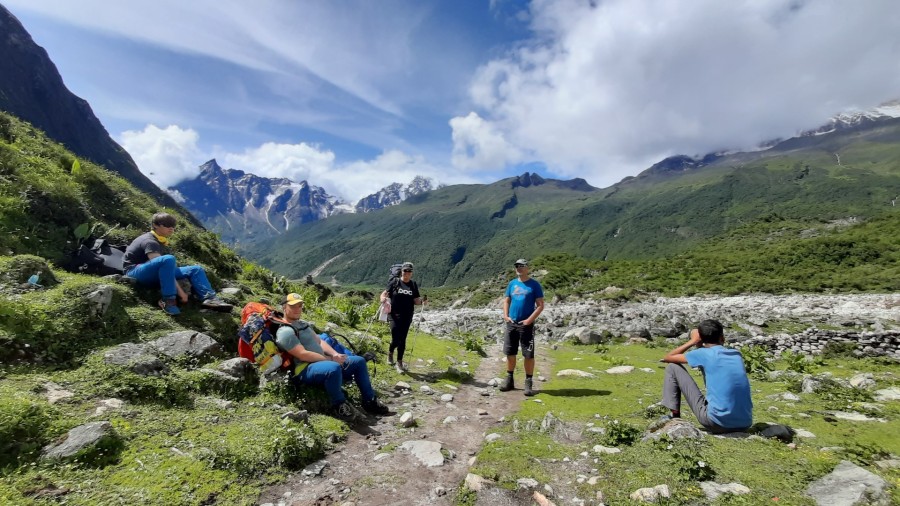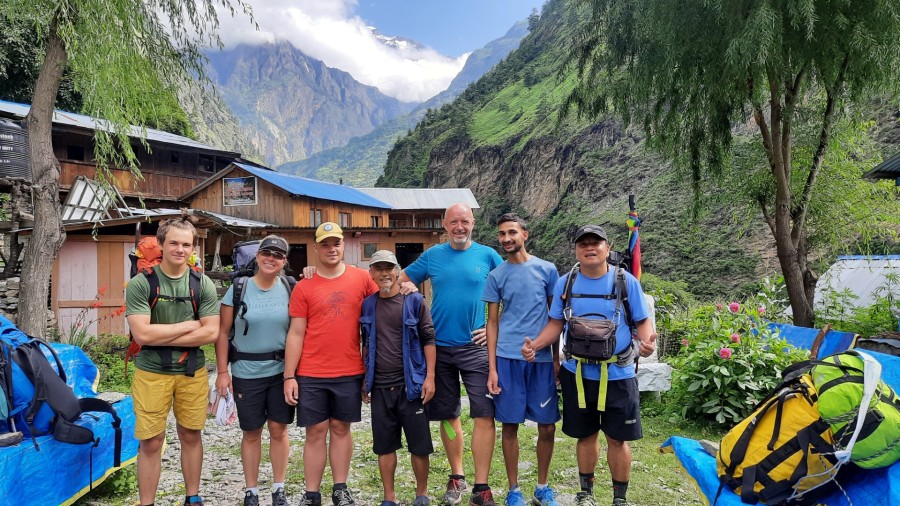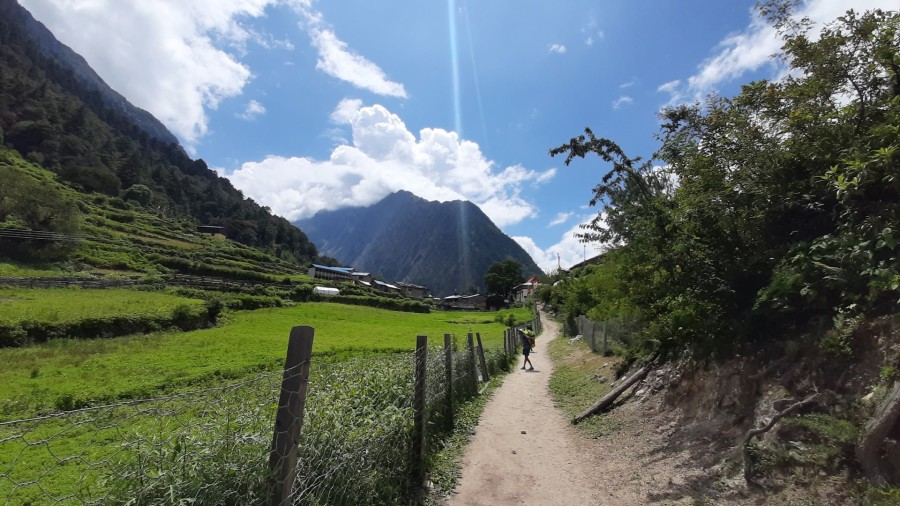Overview
The Manaslu Circuit trek is one of the gems of Himalayan trekking. It delivers beautiful trekking through the lower Himalaya forests and valleys as the trail gradually gains altitude. It visits beautiful hill-top monasteries, the world’s eighth-highest mountain, Mount Manaslu, and then culminates in a final traverse of a high-altitude glacier and the 5,167m altitude Larkya Pass. This trek has everything, but the crowds. And that is a very good thing.
Inclusions
- Airport Pick up & Drop Transportation by private vehicle
- Twin/Double sharing accommodation at Kathmandu in 2-3 star hotel with breakfast.
- Kathmandu / Aarughat/ Soti khola private transportation.
- Twin sharing Accommodation in normal tea house during trek
- 3 Meals with one cup of tea for each meal in trekking
- Sleeping bag
- Dharapani Besisahar local jeep reserve transportation and Besisahar Kathmandu by private transportation
- Trekking map for group
- All necessary paper work & Permits
- ACAP & MCAP
- TIMS
- A First Aid and Eco trained & Government licensed holder English Speaking guide
- One porter between each two clients while on trek
- Accommodation, meals, salary, equipment, transportation & Insurance of guide & Porter
- First aids kit
- Travel & Rescue arrangement
- All government taxes
- Farewell dinner
Exclusions
- Any international airfares
- Nepal Visa fee (US$ 50 per person for 30 days)
- Lunch/Dinner in Kathmandu
- Tea coffee in Lunch & Dinner time during trek
- Drinking water,Electricity bills, hot shower during trek
- Tips for guide & Porter & Driver
- Medical evacuation in case of emergency.
- Personal gears & clothing (available on hire)
- Client's insurance, Items of personal nature i.e. Soft/hard drinks etc.
- Expenses incurred due to mishaps, landslide, strikes, political unrest etc. In such case extra will be charged as per actual
- Anything not specified in cost include section.
-
1
Day 1. Kathmandu arrival (1,300m)
Langtang Ri Trekking & Expedition representative will greet you in an airport & transfer you to your Hotel , after refreshment you will be picked from hotel lobby to office where you will be formally introduced to your Guide and the activities to be enjoyed over the next few days. We will also ask for your passport photographs and any other details required for your trek permits, at this stage.
-
2
Day 2. Kathmandu sightseeing (1,300m)
After breakfast, we start an interesting tour around Kathmandu. Escorting by an English speaking guide (can be provide any language speaking guide on request) be, try to give them a full taste of our vivid culture image and an enchanting manner of its people. In our sightseeing tour we go to Monkey temple Swayambhunath, Pashupatinath, Bouddhanath and Kathmandu Durbar square. Bouddhanath: Bouddhanath is a Buddhist religious complex with a history dating back over 500 years. Located on the eastern edge of Kathmandu it is now a site of great pilgrimage for Buddhist followers who circle its massive stupa, spin its many prayer wheels and visit its beautiful monastery. The main feature of Boudhanath is its huge hemispherical white stupa with central golden tower and the all-seeing eyes of the Buddha. Visitors should circle the stupa in a clockwise direction and spin prayer wheels for good fortune and a good life. Visitors may also enjoy visiting the Thangka painting school within the complex to see highly skilled artists at work on religious mandala paintings. Pashupatinath: Hindu Temple is a very large and complex and focal point for the Hindu religion. This old and very revered complex of buildings and shrines is dedicated to the Lord Shiva, one of the main deities of Hinduism. While Lord Shiva has multiple forms he is often seen as the destroyer. This has great significance for the Pashupatinath temple as it is the site of many Hindi ritual cremations each day. Pashupatinath is considered by Hindus to be an auspicious site for passing from one stage of life to the next through the purifying and destroying flames of cremation. However, on a happier note, visitors may also get to see the temple in a buoyant festival mode with one of the many Hindu festivals celebrated here through the year. Swayambhunath: You will first visit the Swayambhunath temple complex that sits atop a high hill overlooking Kathmandu and the entire Kathmandu Valley. Swayambhunath is perhaps the most sacred Buddhist pilgrimage site in Nepal. It consists of a very large white stupa with the all-seeing-eye of Lord Buddha plus many small stupa and beautifully carved stone shrines. This is a wonderful place to catch your breath and start to understand and appreciate the deep importance of Buddhist belief to the people of Nepal and the Himalaya region. Make sure you ring the many bells to awaken the gods and let them know you are in Nepal. Take the time to enjoy the view over Kathmandu and have your guide point the many other highlights of the city. In the far distance to the east you may also be able to see the hills of Nagarkot where your hotel for tonight is located. If you feel energetic you might also like to try some or all of the 350 steps that lead all the way from Kathmandu city up to your Swayambhunath temple vantage point. Kathmandu Durbar Square: The next stop today is the beautiful Kathmandu Durbar Square, or the royal palace square of the ancient Malla kings of the Kathmandu Valley. This square and all its architectural treasures are a UNESCO World Heritage Site. While some damage to buildings occurred in the 2015 earthquake the site still contains many stunning architectural gems. The original royal palace courtyards are open to visitors and you will marvel at the intricate timber carving and beautifully crafted brickwork of the palace. The open square outside the palace has many beautiful multi-storey pagodas and temples with ornate carving and carpentry artwork that tells some of the story of the ancient kings and their mystical time and beliefs. The square also contains many important Hindu temples and statues such as to Vishnu and Lord Shiva. Durbar Square also contains the unique and intriguing Kumari Chok. This is an ancient and ornate house where resides the Raj Kumari – the Living Goddess. She is a young girl chosen through an ancient and mystical selection process to become the human incarnation of the Hindu mother goddess, Durga. If you are in the courtyard of the home at the right time in the afternoon you may see a brief glimpse of the Goddess at her window.
-
3
Day 3. Kathmandu to Arughat bazar to Machha Khola (870m/8hrs)
After breakfast, drive to Aarughat. The road till Dhading has a asphalt. The unsealed road from Dhading to Arughat bazaar is sometimes impassable after heavy monsoon rain. The path will go along the Buri Gandaki all the way to its headwaters. The trail goes across forests populated by monkeys. When you reach wide area of rice paddies you will come to Arkhet. From here trail descend to a high cascading waterfall to kyorpani. This is a small village where there is Magar and Gurung people are living. From here, trail descends to Soti Khola. There is a good swimming hole and a small water fall just above the trail. From here, the course will repeat ascents and descents to Almara, a village on the flank .move on , traversing the forest area. Continue a steep ascent on the rocky path , you will come across a stream.The trail eventually makes its way down and past a few rice terraces, then up to the Gurung village of Lapubes and eventually reach Machha Khola.
-
4
Day 4. Machha Khola to Jagat (1,340m/8hrs)
From here , traverse the slope that has farm fields and rice paddies .further ahead the valley will become a wider. There is views of Sringi Himal also called Chamar ( 7187m) . The path will will go down to the shores of white sand .trail still descends and ascents to mountain flank. After short decent you will reach to Kani Goan. It is one of the big village . soon after passing the village and crossing the Machha Khola and Namyung Khola you will reach to Kholabesi. Pass the village and the valley , follow the narrow path soon you will reach to Taopani. where it has a hot spring.
-
5
Day 5. Jagat to Deng (1,860m/6 hrs)
Crossing the suspension bridge and passing through forested area. following the path looks like it is carved in the rock to reach to Doban. Soon after crossing villages and suspension bridge in Doban khola, trail repeating ascents and descents will come to Jagat. It has a beautiful flagstone .
-
6
Day 6. Deng to Namrung (2,630m/6hrs)
Leaving the village and make a small ascending traverse.the path will go down to river shores. Pass the Gata khola village and Shar khola .finally it offering a pleasant walk through bamboo forests to the Deng Khola. You will reach to Deng. At the tiny village of Deng you enter to Nepri. This part of Nepri is known as Kutsang. It is small village of Gurung and it has a strong Tibetain influence. The path will go down to river shores. Steep cliffs continue to surround the valley. Crossing a suspension bridge to reach to Lana. The path will becomes a gentle ascent till Bih. From here on, traverse through the forest to come to farm fields and go through the khani then you are in Namrung.
-
7
Day 7. Ghap to Lho (3,180m/4hrs)
Climbing through a forest of firs, rhododendrons and oaks the trail enters the closely packed houses of Lihi (2900m). The trail leaves the Lihi village and enters another village of Sho (2960m) where you get spectacular views of Manaslu North (7157m) and Naike peak (5515m) and further you reach the small settlement of Shrip. After climbing some time you reach to the village of Lho.
-
8
Day 8. Lho to Sama Gaun (3,520m/3hrs)
After passing through Bengsam village, LI and Khani you will come to Hinan khola. Crosses the streams, you will come to Sho village. From where the views are open Naike peak, Manaslu north peak and Manaslu. Lho has wide farm fields on the gentle mountain flank, it is a large village with many houses and a fine Gimpa. The view from here are excellent. Soon after the junction, you will cross the stream using the wooden bridge and zigzag up the forested area to reach to Honsanho Gompa. Where it has an open view. After crossing Pungen glacier valley will become a wider. Move on from one Chorten to another to reach sama. Which is surrounded by a large number of Mani stones and Chortens. The Gompa on the top of the hill is very fine and worth visiting.
-
9
Day 9. Acclimatize In Samagaon (3,520m)
We will take a a rest and acclimatization day here with an optional hike to Pung-gyen Gompa, or the day can be spent immersing oneself in the daily life of Sama Gompa.
-
10
Day 10. Sama Gaun to Samdo (3,875m/3hrs)
Passing by the foot of the great, white slide that is the Manaslu Glacier we pass the trail that branches off to Manaslu Base Camp. Our path enters a woodland where we might see marmots in the birch and juniper bushes, before a final steep ascent brings us to the charming village of Samdo. The village has a well-established Tibetan refugee community –with Tibet being only a morning’s walk away.
-
11
Day 11. Samdo to Dharmasala (4,460m/4hrs)
It is good day for acclimatization before crossing Larke pass. After an easy first part today we cross the Budhi Gandaki for a final time before the trail gradually rises through juniper and tundra with a viewpoint overlooking the Larkya La glacier. Climbing further we arrive at the Spartan Larkya Rest House.
-
12
Day 12. Dharmashala –Larke pass (5160m) to Bhimathang (3,590m/9hrs)
An early morning start is needed for what is to be a particularly tough and extended day. A pre-dawn start to avoid gale force wind which usually gains in strength after mid-day at the pass. After a long gradual climb alongside a moraine we make a short descent to a glacial lake and reach the head of the moraine (4,700m) which we cross to climb to the ridge top. Four frozen lakes lie below and then it is up to the crest of the Larkya La (5,100m). The reward for these difficult trekking conditions is brilliant westerly views of Himlung Himal, Kangurru and Annapurna II as well as the looming omnipresence of Manaslu. On the steep descent we drop around 600m in less than an hour. Our trail then levels off onto yak pastures before finally reaching Bimtang, a collection of typical summer kharkas.
-
13
Day 13. Bhimthang to Gho (2,515m/6hrs)
We descend on easier terrain through meadows and pine and rhododendron forest, until arriving in Hampuk. Then the path drops further, following the course of the Dudh Khola, crossing the stream fed by the snows of the Kichke Himal and arrive at Karche and then onto the village of Gho – where rice is back on the menu and Nepalese ‘dhal bhat’ is revisited
-
14
Day 14. Gho to Dharapani by walk than drive to Besisahar (960m/8hrs)
Leaving Gho we cross to the eastern side of the Dudh Khola and match the gradient of the river down to Dharapani. Here is Dudh Khola’s confluence with the Marsyangdi and also our meeting with the Annapurna Circuit trail which is ascending towards Manang. From this point , we will take local sharing Jeep to Besisahar.
-
15
Day 15. Drive to Kathmandu (1,300m/7hrs)
The bus journey will take 6-7 hours.
-
16
Day 16. Final Departure (1,300m)
All too soon it’s time to bid Nepal farewell and one realizes that we can never be intimate, only acquainted with this amazing country.
- Prices are subject to change
- Flights & hotel accommodation is subject to availability.
- Conditions Apply



